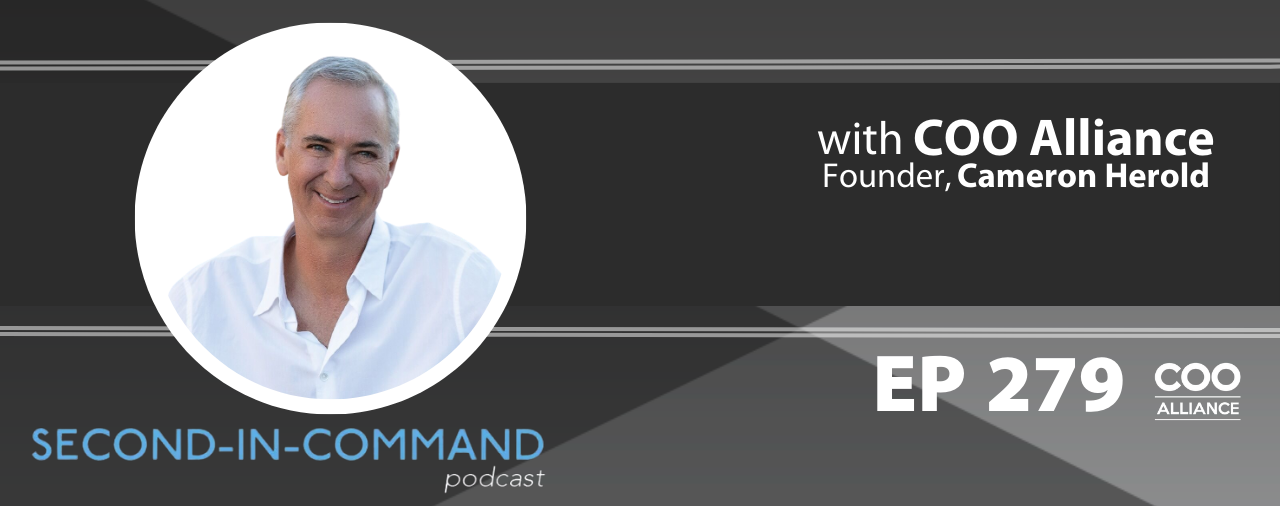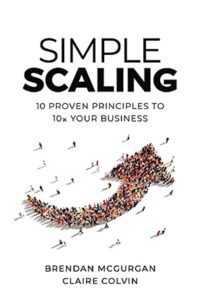As a business scales, the roles within that business must evolve. Staff numbers increase, and the tasks that need to be completed increase as well. At some point, an entrepreneur needs to make the decision to take on a COO to help with the day-to-day execution of the business. This role will itself change and evolve as the business grows, and that evolution is the subject of today’s episode. Cameron discusses the reasons why you should hire an executive assistant before you need a COO and the point at which you likely have your first management team. He also offers thoughts on timing that a particular COO may be effective at one time in the company’s life cycle (from $2 million to $100 million for example), but not as the company gets larger.
Share This Episode On:
In This Episode You’ll Learn:
- Distinguishing between the COO role and the founder role.
- Where to start in the process of hiring a second-in-command.
- Why the CEO’s job is to grow people, not manage them.
- And much more!
Resources:
Connect with Cameron: Website | LinkedIn
Get Cameron’s latest book “Second in Command: Unleash the Power of your COO”
Subscribe to our YouTube channel – Second in Command Podcast on YouTube
Get Cameron’s online course: Invest In Your Leaders
—
In this episode, we’re diving into the dynamic world of business growth. As your business scales up, it’s essential for roles within the company to adapt and evolve. With an increasing number of staff and tasks at hand, entrepreneurs often face the crucial decision of bringing on a Chief Operating Officer or COO to handle the day-to-day execution of the business but here’s the catch. The role of the COO itself goes through transformations as the business continues to grow.
I’ll talk about why it’s beneficial to hire an executive assistant before reaching the point of needing a COO and how timing plays a significant role in determining the effectiveness of a COO. If you’re an entrepreneur navigating the intricacies of scaling your business and contemplating the role of a COO, this episode is a must-read.
—
How do you distinguish between the COO role or that second in command and the founder or CEO?
What happens is as a company starts to grow, I think of it as the 1s and the 3s. When you’re starting a company, it’s just you. You’re the founder. You do everything. There are some things you do well, and some things you’re not that great at. Also, some things you don’t even like doing. You end up hiring a couple of people and all of a sudden, there are three of you in the company.
You got a couple of people doing lots of things. They’re not experts but they might be a little better in the areas. They might like the areas more, but you can divide and conquer the three of you. You then get to ten people. Your company has ten people. You probably have one manager who is managing a bunch of people, and you still have some direct reports.
That manager may not have more skills than you, but they might like the area more and they spend more time on it. Because they spend time on it, you can get more done. It’s almost like it’s all good enough. It’s minimum viable everything. It’s momentum creating momentum. When you go from 10 people to 30 people, you now probably have your first management team where you have a person leading each of the business areas.
Those 4 or 5 or 6 people report to you and the other 20-ish people report to those 5 or 6. That’s when you probably have your first second in command. You have a person who if you were sick for three months, could take over and run the business for you. You have a person who is behind the scenes and is your real trusted counterpart.
You probably have that one person on your management team who you can sit down with and confidentially say, “I don’t know what I’m doing,” or “I hate this work,” or “I’m super stressed.” They go, “I got it, boss. I’ll take this for you.” It’s almost the yin and yang. When you go from 30 to 100 people, you now have your first leadership team of very seasoned and solid leaders in each business area.
Most of them will have to run those business areas for at least one other company before. That’s probably when you have your first COO versus a VP of Ops or a Director of Ops. That’s the migration point. For anybody who’s very early on in the entrepreneurial journey, in the 1 to 30 employee stage, if you don’t have an executive assistant, you are one.

COO Role: If you don’t have an executive assistant, you are one.
The key thing you need to do before you hire a second in command is hire an executive assistant to get all of that admin work and the minimum wage jobs off your plate. Also, all of the tasks that drain you of energy off your plate so that your EA can handle all of that to free you up to work on the bigger business ideas. When you’ve got too many of the bigger stuff, then you can get the first second in command.
I had Jack Daly on the show.
Jack is the guy who first said it.
It’s so profound. Essentially, and I can relate to this, the exec assistant precedes and maybe can graduate into the role but certainly precedes that COO.
They might be able to graduate into a Director of Ops role, but it’s going to be very hard for an executive assistant to ever move in into the C-Suite unless they’ve had a number of companies under their belt. It’s too big of a stretch, or unless your company scales by 7% to 10% a year for ten years, then they can grow with you. If you’re on a real rapid growth trajectory of 25% or more annually, you need to start hiring the people that have done it before. You can’t just hire for cultural fit. You need to hire skills as well.
Those tuning in, many of them will relate to you. They will either be sitting in that 10 to 30 band or the 30 to 100 band. If they don’t have this second in command already in place, where do they start?
Dan Sullivan who started Strategic Coach created an interesting system called the Activity Inventory. The Activity Inventory is when you sit down and you think about all the stuff that’s on your plate. The great exercise that I try to explain to people is to pretend that someone followed you around with a video camera for an entire month, almost like Gary Vaynerchuk. You’ve got somebody videoing everything you do for 30 days. You then play back the video and write down everything you see yourself doing.

COO Role: The Activity Inventory is when you sit down and you think about all the stuff that’s on your plate.
“I did a media interview. I booked a flight. I went to a one-on-one meeting. I showed up at the leadership team meeting. I reviewed the dashboard. I reviewed the financials. I opened emails. I replied to emails.” You might end up with 80 or 90 things that you do over the course of a month, every task. I open up a spreadsheet and I write down every single task, one task per row in column A of the spreadsheet. Now, I’ve got 80 or 90 things that I do.
In column B, I categorize each task in one of four ways. Either I, for Incompetent, meaning I suck at it. C for Competent, meaning I’m okay at it. E for Excellent, meaning I’m really good at it, but I don’t necessarily love doing it, and then U, for Unique ability, which is the stuff I love to do. I’m good at it. I get energized by doing it. That’s column B.
Column C, and this is what I’ve added to the model. If you were to pay someone to do that one task every day, all year, what would you pay as the hourly rate? What would you pay to clean toilets? What would you pay to open emails? What would you pay someone to book flights? What would you pay someone to do speaking?
You end up with this long list of things with a price associated with them. The first thing the CEO needs to do is say, “Who can I push or delegate all this stuff off to? Can I get it out to an EA? Can I get it to other people?” At some point, you end up with a basket of things that you need a true second in command to do. You’re going to take all the stuff that drains you of energy, all the things that you might be excellent at, and you’re going to hire somebody who loves to do those things. I hate finance. I hate IT, but there are COOs out there that love IT and finance. The key is how do you find that yin and yang of someone who loves to do the stuff that you’re bad at and who doesn’t want to work on the areas that you love? That’s the starting point.
I noticed that within the book. You gave a breakdown of that. I also like it because of the acronym ICE in terms of Incompetence and Competence. Moving on, we’ve now got an understanding. Certainly, for those founders, as they begin to scale their companies, they’re taking on more and more. Taking the time to do this is fundamental to creating a level of awareness in the first instance.
If the CEO is ever saying to themselves, “I don’t have time to do this deep work or this thinking work or this strategy work,” it’s time to hire a second in command. It’s because the CEO needs to have time to think, to be strategic, to do networking, and to go to the mastermind groups. Also, to stay at the 30,000-foot level or at the top of the mountain looking at where we’re going, and then coming back to tell the team where we’re going, and then getting out of their way again.
If the CEO is spending all their time managing people or trying to keep it all together, you have no time to grow people. The reality is the leader’s job is to grow people, to grow their skills, and to grow their confidence. If any leader doesn’t have time to grow their direct reports, remove obstacles for them, help them, mentor them, coach them, and cheer them on, then the leader is too stretched.
Something that resonated is the term I use myself. It’s the acronym CEO. I don’t think of it as Chief Executive Officer, but rather Chief Energy Officer. If your energy is leaking and dissipating as a result of doing things that you absolutely hate, then this is the trigger for you to get somebody. If you’re in the early stages of scaling the executive assistant, or if you’re in the more mature stages of scaling, then look for this second in command or the yang to your yin.
What is super interesting is there’s a time period in which a COO might be a good fit for your organization and might not be. I was a great COO for 1-800-GOT-JUNK? from $2 million to $100 million, but I was the wrong guy to take it from $100 million to the billion. They then replaced me with the former president of Starbucks, United States. She came in and thought, “What a cute little company.”
Meanwhile, I’m pulling my hair out because it was so big. She only lasted a year. She was too corporate and too bureaucratic. It didn’t fit. Brian replaced her and then we finally found a guy named Erik Church. Erik has been the COO for 1-800-GOT-JUNK? and O2E Brands for almost ten years now. He’s been amazing. After I left, it went from $100 million down to $70 million. Erik came in and took them from $70 million up to $450 million.
Erik as COO would’ve been horrible in the first six years. The reason I know this is Erik and I have been friends for 35 years. This is so weird. Erik and I started a fraternity together in 1987 in Ottawa, Canada. Get this though. I was president the first year and Erik was president the second year. I also recruited Erik and got him into a company called College Pro Painters. I know his skillset.
Erik didn’t know the franchising world well enough to have taken them from $2 million to $100 million. He would have been horrible because he didn’t know how to do things, but I didn’t know how to operate a big business and that was where he was good. There was a time period when you have to be the right person at the right time. Brian talks about that as well in the book for me.
Important Link
- book – The Second In Command






